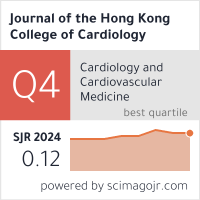Abstract
Background
Pacemaker-detected atrial fibrillation (PDAF) and its burden are associated with adverse clinical outcomes, but consensus is lacking on its definition and local clinical outcomes are unclear. We evaluated PDAF, its burden and relationship with major adverse cardiovascular and cerebrovascular events (MACCE).
Methods
This retrospective study recruited adult patients receiving dual-chamber pacemakers from 2014 to 2022. The presence of PDAF of 5 minutes, PDAF burden (defined by the longest episode) and time to new-onset PDAF were measured and analysed. High PDAF burden was defined as PDAF lasting 24 hours.
Results
A total of 275 patients were analysed and followed for a median of 5 years. Ninety-five patients had PDAF. Patients with PDAF were more likely to develop composite MACCE (HR 1.58 (95% CI 1.06-2.35), p=0.025). It also conferred worse prognosis in terms of time to MACCE (Odds Ratio (OR) 1.76 (95% CI 1.05-2.93), p=0.031), especially with cardiac hospitalisations. High PDAF burden trended towards more stroke/systemic embolism episodes, but was not associated with composite MACCE (Hazard Ratio (HR) 1.25 (95% confidence interval (CI) 0.60-2.61), p=0.559). In patients without prior AF, a higher baseline non-AF atrial high-rate episode (AHRE) burden was associated with new-onset PDAF (OR 1.36 (95% CI 1.01-1.83), p=0.017).
Conclusions
Patients with PDAF were more likely to develop composite MACCE, with PDAF of 5 minutes being associated with more and shorter time to MACCE. High PDAF burden trended towards more stroke/systemic embolism episodes. A higher baseline non-AF AHRE burden predicted new-onset PDAF.
Recommended Citation
Ka Ho Oscar CHIU, Shou Yan KAM, Ka Chun Kevin LEE, To Shing WONG, Jacky Kit CHAN, Yuk-Kong LAU, Kwok-Lun LEE, Wai-ling Jessica POON, Atrial fibrillation burden and clinical outcomes in dual-chamber pacemaker recipients Journal of the Hong Kong College of Cardiology 2025;32(1) https://doi.org/10.55503/2790-6744.1554
Creative Commons License

This work is licensed under a Creative Commons Attribution-Noncommercial-No Derivative Works 4.0 License.



